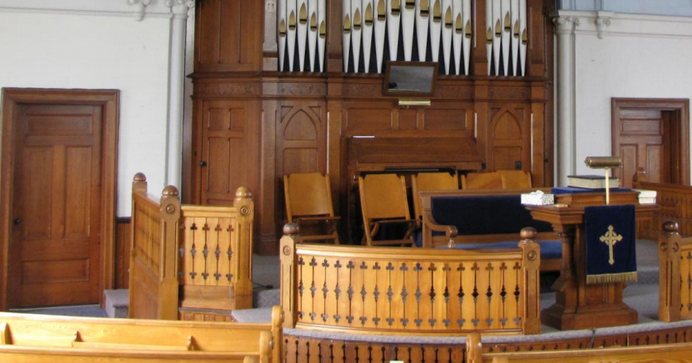The congregation said good-bye to its church home when the 15 remaining members officially closed St. James Presbyterian Church in Thamesville on Sun. Nov. 30, 2014.
The congregation thus ended its 148 years of Christian worship and witness in the community.
However, there will be one last event in the building to which the public is invited.
It is a once-in-a-lifetime not-to-be missed music concert. It will feature organ pieces, soprano solos, soprano duets and congregational hymn singing appropriate to the year 1900 when the building was opened.
It is sponsored by the National Presbyterian Museum as a fund-raiser.
Soprano soloists are Karianne Pasma, soprano section leader of Bishop Cronyn Memorial Anglican Church of London, Ont. and Suzanne Schaafsma, soprano section leader of Knox Presbyterian Church, Spadina, Toronto. The organist is Dr. Roger Bergs, organist and choir director of Knox Presbyterian Church, Spadina, Toronto.
Suzanne Schaafsma is known locally and was raised in Ridgetown. She is a student in voice in the doctoral program at the University of Toronto.
Special guests will be a choir made up of members and friends of Trinity Associate Reformed Presbyterian Church in Chatham. The choir will sing a few Psalms in the style that Presbyterians used prior to 1875. Prior to 1875, Presbyterian Churches in Canada generally forbade the use of any musical instruments such as pianos or organs to accompany singing.
Hymns were not allowed to be sung.
A capella Psalm singing was the only form of music that was considered appropriate. Pastor Henry Bartsch of Trinity Church will take on the role of precentor.
A precentor was the Psalm leader.
He will demonstrate the practice of “lining” used when a congregation was unfamiliar with a tune.
The Presbyterians in Thamesville would have followed the practice of exclusively singing the Psalms prior to 1875.
In the 1890s less than a generation later, they had abandoned this practice and were singing with a reed pump organ.
The new St. James Presbyterian Church was opened on Sun. Dec. 2, 1900.
The congregation had to wait a little while before their new pipe organ was installed. It was first used during worship on Sun. Dec. 23, 1900.
The first organ recital was held the next day on Christmas Eve and was not very well attended because of all the shopping and preparations which had to be done.
The instrument was produced by the Karn-Warren Organ Co. of Woodstock, Ont. Mr. Dennis W. Karn was a farmer and amateur musician whose passion was producing pianos.
When an opportunity to buy the highly respected S. R. Warren Organ Company of Toronto became available in 1896, he quickly purchased it and acquired this company’s expertise in building pipe organs.
The pipe organ is a tracker, also known as a mechanical action organ. This means that the organist has their back to the congregation and also the choir.
This is because the keys are directly linked to the pallets under the pipes, without any electrical or pneumatic transmission. The pallets allow air to enter the key channel which directs air to the pipes.
When a key on the organ is pressed down, it opens the pallet and allows air from the wind chest to enter the key channel for the pipes of similar pitch above it.
A slider mechanism, a wooden board with holes drilled into it, is also a part of the process.
The slider mechanism is controlled by the stops or knobs on the organ console.
When both the pallet is open and the hole of the slider mechanism is open under the pipe, the selected pipe produces its sound.
The organ is considered fully Canadian-made. The name plate on the organ console was made in New York City; the reciprocating water engine which originally powered the bellows was likely manufactured in Troy, New York; the pipes were made by Karn; and the man who voiced, or tuned, the pipes was F. C. Kupfer, an American who worked for the Farrand and Votey Organ Co. of Detroit, Michigan.
The technology is attributed to Samuel Russell Warren, a New Englander, who arrived in Canada in 1870 to become Canada’s largest 19th century manufacturer and distributor of pipe organs.
Don Pole, of Pole and Kingham Organ Company of Chatham, says that although the Thamesville church’s organ was at one time very common, it is now a rare instrument. “Larger churches which owned these types of organs would have replaced them with more up to date organs which featured an electro-pneumatic system.
Sometimes the pipes of the old tracker organs were re-used, but the trackers and the original Warren and Karn Warren consoles were discarded.”
A feature that will make this concert so memorable is the outstanding got-to-be-heard-to-be-believed acoustics of the church’s sanctuary.
The architectural firm of Gregg and Gregg with its lead architect of William Rufus Gregg designed a space that has long been known locally to have superior acoustic properties.
Gregg’s mastery of acoustical engineering in the St. James, Thamesville church would find few equals among the buildings constructed in Canada for worship and the performing arts in the 115 years since it was built.
This church has an historic significance as well because of its connection with a great Canadian writer.
This was the home church for Robertson Davies and his family. Davies’ father, William Rupert Davies, was the publisher and later owner of The Thamesville Herald from 1907 to 1919.
Robertson, who was born in Thamesville in 1913, spent the first six years of his life attending this church with his family.
In 1919, his father moved the family to Renfrew, Ont. where he was the publisher and owner of The Renfrew Mercury.
To help emphasize the historical setting of this concert, any member of the audience is invited to wear 19th century clothes to the concert.
There may be some local re-enactors from the Kent Military Re-enactment Society who will be outfitted with their early 19th century attire. Concert producer, Ian Mason, member of the Advisory Committee of the National Presbyterian Museum explains the justification for wearing clothes that would be considered very old-fashioned in the year 1900.
Mason said, “Although the clothes of the early 19th century would not have been worn commonly at the turn of the 20th century, Ontarians were beginning to think about the early pioneer period, realizing that if they did not commemorate it, it would be lost to time.
The province-wide Ontario Historical Society was founded in 1888 and one of the province’s early historical societies was the Kent Historical Society. It was established in 1912 by Dr. Tecumseh Kingsley Holmes, a Chatham surgeon who had a life-long interest in the history of Chatham and Kent County.”
Mason says, “Come and give St. James a great send-off hearing and singing the types of songs that would have been heard in the year 1900, the year the church opened!”
What: Farewell Concert for St. James, Thamesville
When: Fri. May 29, 2015 at 7 pm
Where: St. James Presbyterian Church, Thamesville: 29 Ann Street at corner of Sherman Street
Admission: Advance Tickets: Adults – $20; Seniors, students, under-employed – $15; Youth (12-18) – $5; children under 12 – free. At the door, tickets are an additional $5. Tickets are available from B’s Hive Flowers & Gifts, 9 Victoria St. (two doors from post office), Thamesville, Ont. (519-692-5519) or by contacting Ian Mason (519-864-1119; ilmason773@gmail.com).
Sorry, no reserved seats.
Doors open at 6:30 pm.

















